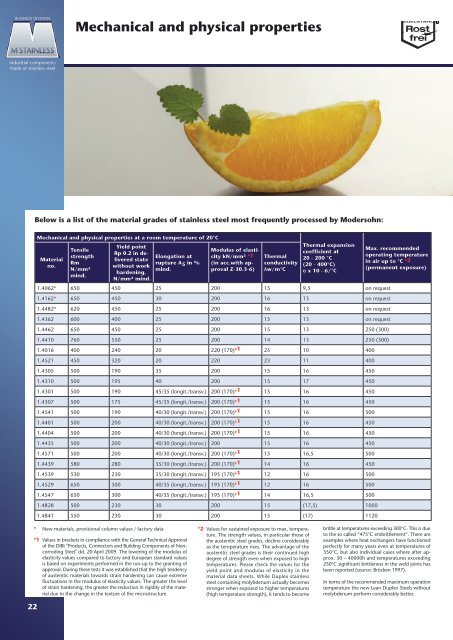The Stainless Steel Experts - MSTAINLESS
The Stainless Steel Experts - MSTAINLESS
The Stainless Steel Experts - MSTAINLESS
Create successful ePaper yourself
Turn your PDF publications into a flip-book with our unique Google optimized e-Paper software.
BUSINESS DIVISION<br />
Industrial components<br />
made of stainless steel<br />
22<br />
Mechanical and physical properties at a room temperature of 20°C<br />
Material<br />
no.<br />
Mechanical and physical properties<br />
Below is a list of the material grades of stainless steel most frequently processed by Modersohn:<br />
Tensile<br />
strength<br />
Rm<br />
N/mm²<br />
mind.<br />
Yield point<br />
Rp 0.2 in delivered<br />
state<br />
without work<br />
hardening,<br />
N/mm² mind.<br />
Elongation at<br />
rupture A 5 in %<br />
mind.<br />
Modulus of elasticity<br />
kN/mm² *1<br />
(in acc.with approval<br />
Z-30.3-6)<br />
<strong>The</strong>rmal<br />
conductivity<br />
λw/m°C<br />
<strong>The</strong>rmal expansion<br />
coefficient at<br />
20 - 200 °C<br />
(20 - 400°C)<br />
α x 10 - 6/°C<br />
1.4062* 650 450 25 200 15 9,5 on request<br />
1.4162* 650 450 30 200 16 13 on request<br />
1.4482* 620 450 25 200 16 13 on request<br />
1.4362 600 400 25 200 15 13 on request<br />
1.4462 650 450 25 200 15 13 250 (300)<br />
1.4410 760 550 25 200 14 13 250 (300)<br />
1.4016 400 240 20 220 (170)* 1 25 10 400<br />
1.4521 450 320 20 220 23 11 400<br />
1.4305 500 190 35 200 15 16 450<br />
1.4310 500 195 40 200 15 17 450<br />
1.4301 500 190 45/35 (longit./transv.) 200 (170)* 1 15 16 450<br />
1.4307 500 175 45/35 (longit./transv.) 200 (170)* 1 15 16 450<br />
1.4541 500 190 40/30 (longit./transv.) 200 (170)* 1 15 16 500<br />
1.4401 500 200 40/30 (longit./transv.) 200 (170)* 1 15 16 450<br />
1.4404 500 200 40/30 (longit./transv.) 200 (170)* 1 15 16 450<br />
1.4435 500 200 40/30 (longit./transv.) 200 15 16 450<br />
1.4571 500 200 40/30 (longit./transv.) 200 (170)* 1 15 16,5 500<br />
1.4439 580 280 35/30 (longit./transv.) 200 (170)* 1 14 16 450<br />
1.4539 530 230 35/30 (longit./transv.) 195 (170)* 1 12 16 500<br />
1.4529 650 300 40/35 (longit./transv.) 195 (170)* 1 12 16 500<br />
1.4547 650 300 40/35 (longit./transv.) 195 (170)* 1 14 16,5 500<br />
1.4828 500 230 30 200 15 (17,5) 1000<br />
1.4841 550 230 30 200 15 (17) 1120<br />
* New materials, provisional column values / factory data<br />
*1 Values in brackets in compliance with the General Technical Approval<br />
of the DIBt "Products, Connectors and Building Components of Noncorroding<br />
<strong>Steel</strong>" dd. 20 April 2009. <strong>The</strong> lowering of the modulus of<br />
elasticity values compared to factory and European standard values<br />
is based on experiments performed in the run-up to the granting of<br />
approval. During these tests it was established that the high tendency<br />
of austenitic materials towards strain hardening can cause extreme<br />
fluctuations in the modulus of elasticity values. <strong>The</strong> greater the level<br />
of strain hardening, the greater the reduction in rigidity of the material<br />
due to the change in the texture of the microstructure.<br />
*2 Values for sustained exposure to max. temperature.<br />
<strong>The</strong> strength values, in particular those of<br />
the austenitic steel grades, decline considerably<br />
as the temperature rises. <strong>The</strong> advantage of the<br />
austenitic steel grades is their continued high<br />
degree of strength even when exposed to high<br />
temperatures. Please check the values for the<br />
yield point and modulas of elasticity in the<br />
material data sheets. While Duplex stainless<br />
steel containing molybdenum actually becomes<br />
stronger when exposed to higher temperatures<br />
(high temperature strength), it tends to become<br />
Max. recommended<br />
operating temperature<br />
in air up to °C *2<br />
(permanent exposure)<br />
brittle at temperatures exceeding 300°C. This is due<br />
to the so called “475°C embrittlement”. <strong>The</strong>re are<br />
examples where heat exchangers have functioned<br />
perfectly for many years even at temperatures of<br />
350°C, but also individual cases where after approx.<br />
30 – 40000h and temperatures exceeding<br />
250°C significant brittleness in the weld joints has<br />
been reported (source: Brücken 1997).<br />
In terms of the recommended maximum operation<br />
temperature the new Lean Duplex <strong>Steel</strong>s without<br />
molybdenum perform considerably better.


